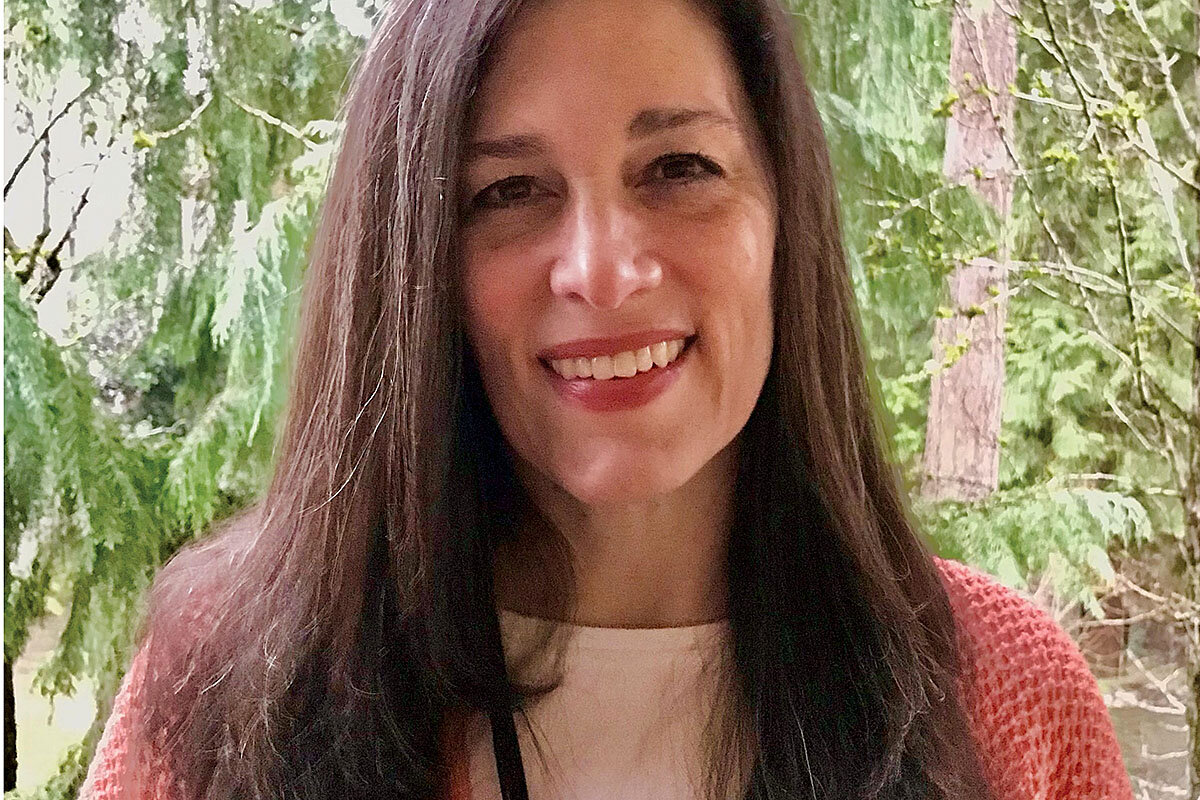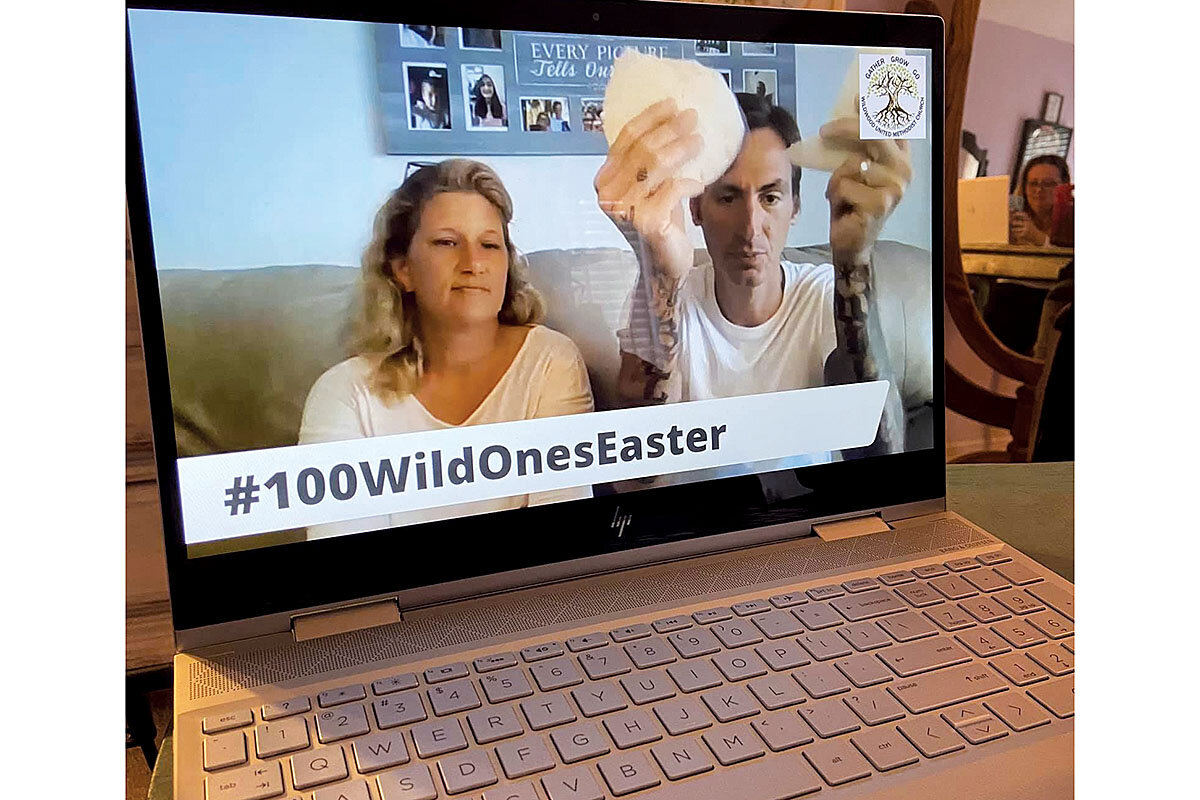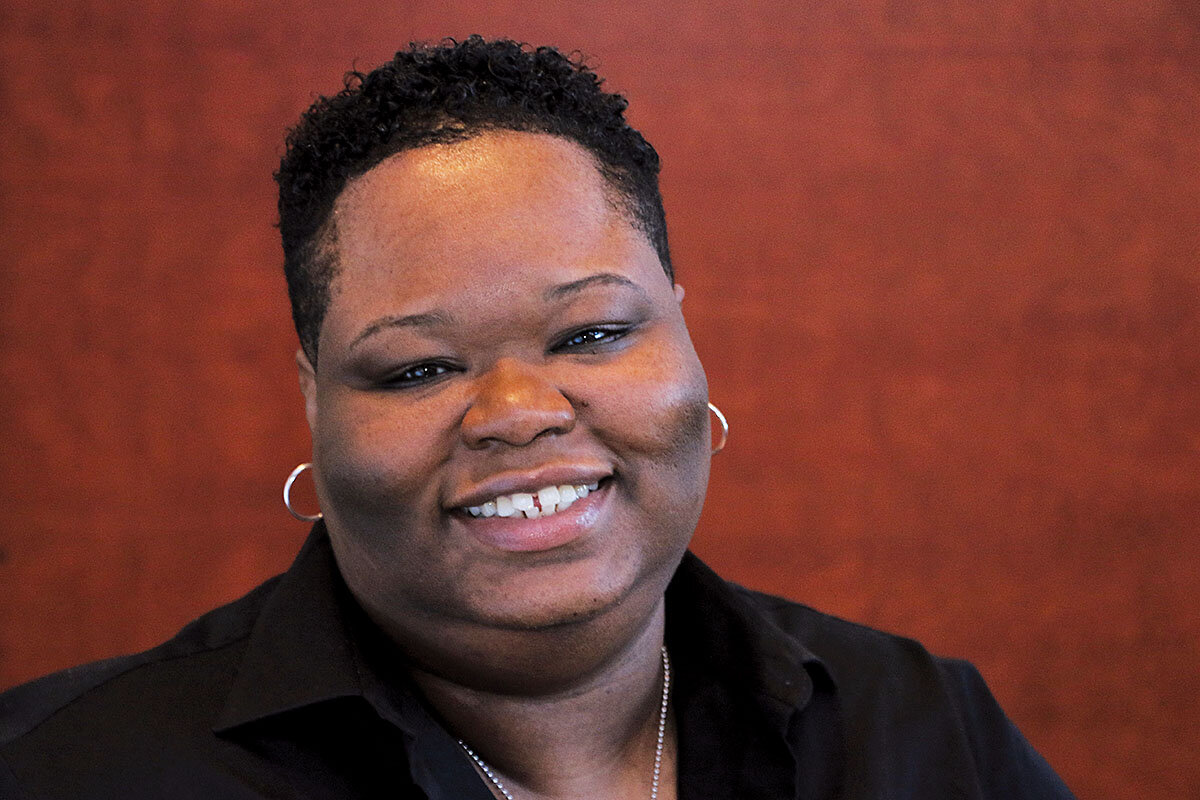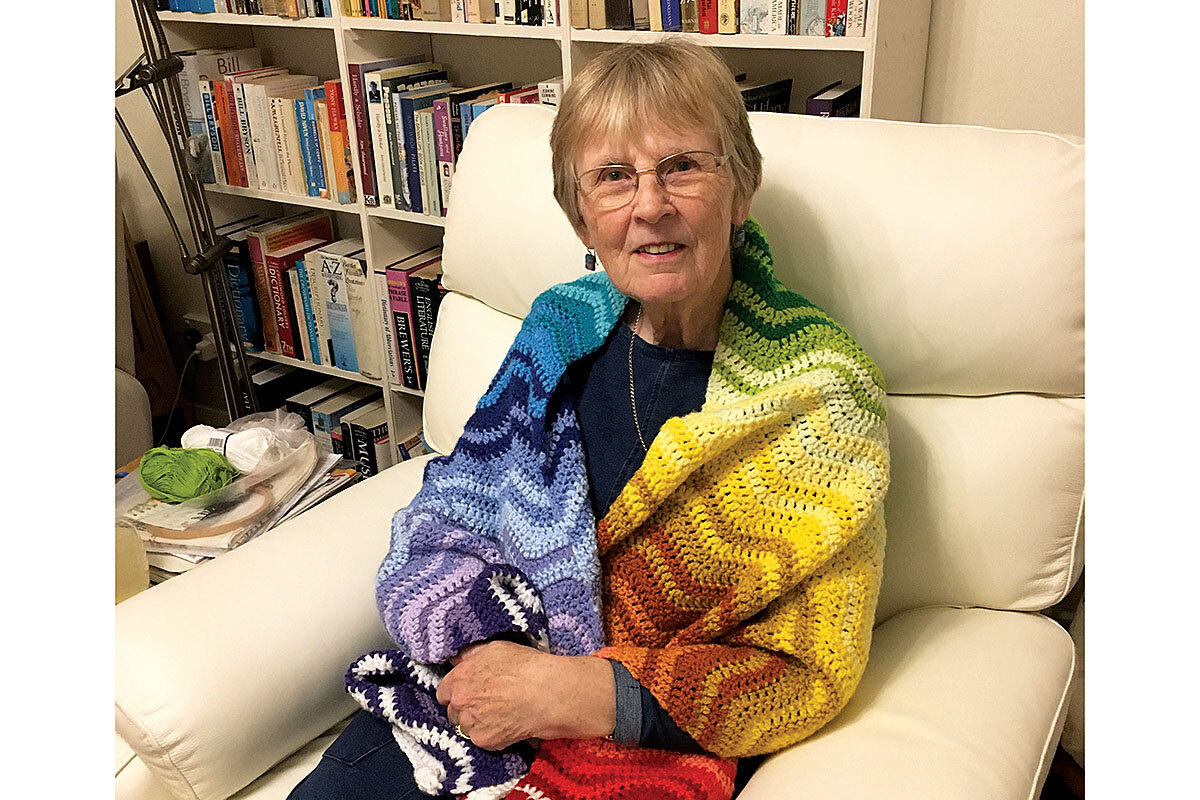No pew? No problem. Online church is revitalizing congregations.
Loading...
After spending five years in Vietnam for her husband’s work assignment, Beth Schultz looked forward to reconnecting with church life in 2016 when her family returned to Portland, Oregon. But she easily gets overwhelmed in groups, she says, and she didn’t feel a warm welcome at her church. She tried practicing faith independently, but habits were hard to sustain with no community support.
All that changed last year, however, when joining another church became an option – a church 2,000 miles away.
Ms. Schultz began worshipping at Wilshire Baptist Church in Dallas, one of many making room during the pandemic for new “virtual members” who attend only online. She watches services on YouTube in her bathrobe, attends social gatherings on Zoom, and is glad to be rid of what she calls “the judgment factor” that she’s too often felt when visiting churches in person. So when Wilshire Senior Pastor George Mason started inviting online attendees to join the congregation, no matter where they live, she eagerly signed up.
Why We Wrote This
As churches have had to go online to hold services during the pandemic, they have learned something surprising: Practicing religion in cyberspace works. Many have attracted faraway followers and rejuvenated congregations.
“It’s nice to be seen, noticed, and welcomed when you show up alone,” says Ms. Schultz, who tithes to her faraway church and sometimes has a speaking role during worship. “It feels like less pressure when you’re behind a screen. You don’t have to talk, but you can talk when you’re ready to talk.”
It’s a pandemic shift no one saw coming at the start of 2020. Churches that had long assumed their members would live nearby are no longer resigned to geographic constraints. As congregations have gone online to maintain ministries while social distancing, new worshippers from other regions have been showing up. Now some are getting even more involved. They’re becoming part of the fabric of church life as members, regular donors, and active participants in a host of church activities.
“Online really is a way to reach people that maybe we couldn’t reach in a local setting because some people wouldn’t come into a church building,” says Gary McIntosh, professor of ���Ǵ��� ministry and leadership at Biola University in La Mirada, California, and author of 23 books on church growth. “But they will observe a worship service online, and they will get involved in a small group online.”
Just how many congregations are taking in far-flung worshippers is difficult to pin down. But congregations large and small are reporting notable increases. Wilshire, a church of 2,000 active members, has identified 22 new participants during the pandemic who live too far away to attend in person yet are highly engaged, including seven who’ve formally joined. Episcopal Church of the Transfiguration (aka The Fig), also in Dallas, counts 21 faraway people who are deeply involved. This includes new members who live in Tennessee and England, according to Anne Schmidt, director of evangelism and welcoming ministries.
In Florida, the Wildwood United Methodist Church has created a new “network partner” category. So far, 12 distant participants have taken the pledge to “participate digitally as much as possible” among other commitments. Hundreds more take part in what Michael Beck, co-pastor of Wildwood UMC, calls “new forms of digital church.” These include “Create” and “Yoga Church Digital,” which are considered expressions of church in which participants make art and do yoga in ���Ǵ��� devotional contexts.
“For us, ‘virtual’ is real, not less than real,” says Mr. Beck in an email. “Real community forms there with real people. In fact, people seem to be much more open to share personal struggles and get spiritually intimate in an online venue. So we spread these experiences across the whole seven-day workweek, as many people work or do other activities on Sundays.”
Online memberships are changing notions of what church life entails. Faith communities began 2020 expecting members to attend worship in person at least somewhat regularly and receive Holy Communion from a server’s hand. Perhaps they’d come to a potluck lunch now and then toting a covered dish.
Now people can belong, officially or informally, without ever darkening a church door. That raises challenging questions about what it means to be a church where some people can’t take part in defining activities, such as sharing in the Lord’s Supper. Nor can they ever line up side by side to stuff backpacks that will be given to children in need at a nearby school.
“Our new question needs to be: How do we think about mission possibilities that can be adapted to be national or global so that everybody can participate?” says Michelle Snyder, a church consultant in Pittsburgh.
“Like coming home”
Congregations have a lot riding on whether they can turn mere viewers into engaged participants. Part of it is financial. Though a slight majority of churches have seen attendance increase during the pandemic because of their online outreach, 42% say financial giving has declined, according to a September study from the Lake Institute on Faith and Giving at Indiana University-Purdue University Indianapolis. Roman Catholic parishes have been especially hard hit, with 61% reporting declining donations. Small churches have also been squeezed.
The “digital divide has contributed to the struggle to maintain giving in smaller congregations without in-person services,” says the Lake Institute’s COVID-19 Congregational Study. If churches can cultivate online followers, the hope goes, then increased giving will likely follow, as will the spiritual fruits of dedication to practicing faith in a community.
Online ministries have continued even though most U.S. congregations have resumed in-person worship. In September, 79% of regular attendees at religious services said their congregations were still streaming services, according to a Pew Research Center survey.
In fact, churches are starting to regard their distant attendees as more than a curious novelty. They’re shaping the collective character of congregations.
In some cases, opening doors to far-off worshippers means welcoming back those who moved away. Consider All Saints Episcopal Church, a congregation founded about 25 years ago in Bellevue, Washington. With no building of its own, the church convened in pre-pandemic times in a rented office park suite, where about 13 people would show up on a typical Sunday. Now that the congregation meets on Zoom, some 21 people regularly attend, from four time zones. They include once-inactive members who have happily reactivated their status.
Hanne Peterson, for instance, attends from Bellinge, Denmark. She’s been missing All Saints ever since she returned to her native country in 2016, after 50 years working and raising a family in the United States. Having felt disoriented and not warmly welcomed at churches in Denmark, she seized the chance to be active again at All Saints. She’s resumed attending worship and Sunday school. She also receives the newsletter and donates monthly.
“When I log in on Zoom, it’s like coming home,” Ms. Peterson says. “You can listen to or look at any church services [online], but it’s different when it’s a church that’s your church and you know the people in it.”
To accommodate participants from eastern time zones, All Saints changed its schedules. ���Ǵ��� education sessions have moved from Sunday nights to Sunday mornings.
Returning post-pandemic to in-person gatherings with no online component would feel like a step backward, according to the Rev. Josephine Robertson, vicar of All Saints, because distant members would be left out. The church is even starting to discuss going further: possibly becoming an online-only church. That way it wouldn’t have to pay rent.
“A community like mine is going to be asking some really different questions than what churches have asked in the past,” says Ms. Robertson. “What looks for others like, ‘Yay, we get to get back together,’ would be for us: ‘Oh, we’re about to lose a whole bunch of connections to people.’”
A revived congregation
In some cases, long-distance worshipping is bringing congregations back to life. Before the pandemic sparked an exodus from church buildings to cyberspace, Judah Fellowship ���Ǵ��� Church in Pittsburgh was barely functioning. Having lost its pastor, the Rev. Shanea Leonard, to a new job in Kentucky, this largely African American and LGBTQ congregation had not gathered regularly for worship since 2018.
When churches migrated online, Ms. Leonard could suddenly reconnect with her Pittsburgh flock by Zoom from Louisville. Parishioners could pray together and engage in broad theological conversations about issues that often come up at Judah but many other churches don’t broach, from sexual identity to regulating firearms. That led to reconstituting regular worship and church growth.
“People who’ve found the church for the first time are people who reached out personally to me, like some people in New York, who said, ‘We want you to be our pastor,’” Ms. Leonard says.
As word spread about the revived congregation, people became actively involved. Several New Yorkers have joined as members, and the flock has added people in Seattle and New Orleans as well as immigrants from Haiti and Jamaica. The congregation is still based in Pittsburgh, but it’s become a national church with an international flavor.
In Houston, a congregation was started from scratch through long-distance recruiting. Pastor Mike Whang spotted the potential as he was overseeing several small groups at Chapelwood United Methodist Church. When the groups moved online, he asked: Why not draw newcomers from beyond Houston? With that idea, Oikon United Methodist Church was started as an online community on Oct. 1 with participation coming from as far away as California and Australia.
Much of what they experience online is similar to what participants would do in a local church. They join small groups in which they confide personal struggles, emotional wounds, and spiritual progress. Indeed, many say they can sometimes develop more meaningful relationships online than they can attending a local church.
Such was the case for Sharon Cho, who’s long attended United Methodist congregations around Irvine, California. Everyone seemed to know each other at the churches Ms. Cho went to, which made her hesitant to join one. She felt discussing past experiences could be awkward. She’s more comfortable opening up about her spiritual life online among people she won’t run into at the grocery store.
“There is a level of safety when you’re behind a screen,” says Ms. Cho. “When there’s a screen, you can be authentic and real. Then you shut it off and that’s it. You’re done with the interactions. Sometimes when you’re in person, it’s like you can’t escape.”
Others agree that what’s important are the connections you make at church, not whether you’re in the pews or not. Chelsea Adamson got involved with Oikon last year, even though she was in the process of moving from the U.S. to Australia. She had a friend who attended Oikon, and she finds online relationships are as real as those in person. She sets her alarm for 3:58 a.m. on Mondays. Two minutes later, she’s attending her church’s Sunday service in Texas via smartphone from 9,000 miles away. Then on Tuesdays at 1 p.m., she stops whatever she’s doing to meet by Zoom with two women in her small group.
“We all take notes when we’re asking for prayer requests, so they know everything I’m struggling with and it’s not just like, ‘OK yeah, cool, next person,’” Ms. Adamson says. “It’s very, very intimate.”
Finding family
Joining a distant church comes with unavoidable trade-offs. If you’re hospitalized, the pastor won’t be there to pray at your bedside. You won’t make new friends through chance encounters in the parking lot.
Some people worshipping online say they’ll probably affiliate with a local church, even if informally, after the pandemic rather than just tune into services over the internet. They like the intimacy that comes with sitting in the pews and being shoulder to shoulder with fellow parishioners.
Nicole Fike sees benefits in both forms of worship. She was attending a local church in Grayson, Georgia, but wasn’t able to get the congregation to back her idea of holding services at a food pantry. But now she receives guidance and encouragement for her ministry project from Wildwood United Methodist in Florida, 500 miles away, which she joined as a network partner in 2020.
“I was interacting with members of Wildwood three times a week over Zoom, so they became our church family,” says Ms. Fike. “It wasn’t something planned. It just happened.”
Yet Ms. Fike still craves being around people. On a family vacation to Florida last June, she and her husband made sure to meet Mr. Beck of Wildwood; his wife, Jill; and their daughter for dinner. Online church is great for yoga and study, she says, but she still longs to spend a week at Wildwood after the pandemic – and even flirts with the idea of relocating.
“I have thought about moving to Wildwood just because I feel so strongly and support what Michael, Jill, and their leadership team do in their community,” Ms. Fike says.
Others are finding ways to compensate for what they might be missing out on by worshipping online. Retiree Phil Jackson of Delaware, Ohio, joined Wilshire – 1,000 miles from his home – in 2020. Ironically, he’d thought Wilshire was too far when he lived just one hour’s drive away in Arlington, Texas, from 2011 to 2020. But the pandemic shift to online ministry made it feel close enough to take part as a full-fledged member.
So far, he’s been able to do everything locals do: worship, attend Sunday school, participate in fellowship time, and contribute to the collection. While most churches are grappling with how far to go in holding services digitally, Mr. Jackson has decided that, for him, reverting to sitting in pews feels too conventional.
“My personality likes to have a lot more personal freedom,” he says. “So who knows: This virtual membership might have been a heaven-sent opportunity for me. I hope it is.”
In Worthing, England, Ginny Ward is planing to keep her long-distance membership with The Fig, 4,700 miles away in Dallas. Ministries there have helped her navigate some important personal decisions, which led her to join the church when it became an option last year.
On Sundays, she gets up at 1 a.m. to tune into the service and participate in other activities, such as a session with volunteers who make prayer shawls for people experiencing hard times.
“I do it to get to know them more deeply and pray for their concerns and their lives,” says Ms. Ward. “There’s been an awful lot going on in the [U.S.] lately, and I don’t just mean the pandemic. I feel a connection, and I want to grow that connection.”
For in-person support, she maintains her local membership at a nearby Worthing church, where she has introduced the prayer shawl ministry.
Virtual services here to stay?
To foster long-distance connections, congregations are starting to designate people to tend specifically to cyberspace flocks. For example, Long Hollow Baptist Church outside Nashville last year created a new position for Andrew Bolton – digital pastor.
“Yesterday I was talking to a guy in Montana who’s been joining us online for the past couple of months,” Mr. Bolton says. “Now he’s trying to figure out: ‘How do I get in a life group? I live in Montana.’”
As churches cultivate online participation, they can use it to reach out to regular members, too, who may not be able to attend services because they work on weekends or have moved away temporarily.
“This is a vast improvement in the delivery system for a majority of congregations,” says Scott Thumma, director of the Hartford Institute for Religion Research and co-author of “The Other 80 Percent: Turning Your Church’s Spectators Into Active Participants,” in an email.
One other advantage of digital services may be to draw new people to church altogether. This might include young people who are interested in spirituality but wary of organized religion. Others may desire the support of a church community but don’t want to sit in the pews to get it.
“Now you’ve got millennials who’re looking for online community,” says Ms. Snyder, the church consultant in Pittsburgh. “You’ve got baby boomers who’re becoming shut-ins and need online community. You’ve got introverts who aren’t comfortable in crowds, and you’ve got single people who feel awkward going to a church alone. You’ve got all of these people who’re largely unreached by church as we’ve done it. If we can move to online platforms that engage those people ... it could make all the difference in the world.”









